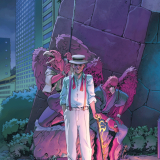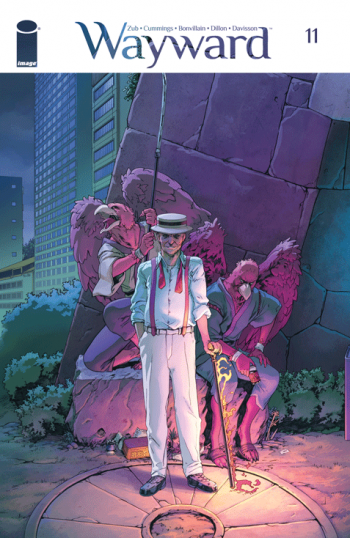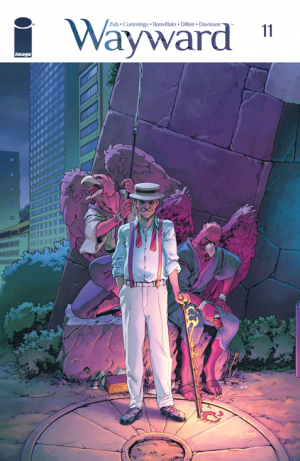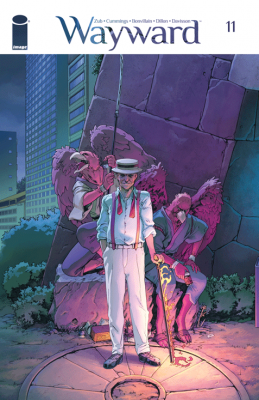
COMIC BOOK REVIEW: Wayward #11
THE CONSEQUENCES Paraphrasing one of our premier heroes’ (Jose Rizal’s) remarks on the scenario and outcomes of the “below” taking over the old regime, the former can be the worst leaders than the latter’s regime. Moreover, remember how the French Revolution turned out before Napoleon Bonaparte took over France and ended it. These historical tidbits […]
Paraphrasing one of our premier heroes’ (Jose Rizal’s) remarks on the scenario and outcomes of the “below” taking over the old regime, the former can be the worst leaders than the latter’s regime. Moreover, remember how the French Revolution turned out before Napoleon Bonaparte took over France and ended it. These historical tidbits are in my thoughts upon reading the third story arc opening of Jim Zub and Steve Cummings’ Wayward #11. The “new kids on the block” takes over the role as the “new gods” of Japan, and the repercussions are already felt after three months (or last issue, #10) as the old guards lament and preparing for a counterattack of sorts in the guise of Star Wars: Revenge of the Sith (the best of the prequels). They are reeling, while the neophytes are just getting started. New characters are presented as conventionally and decently as possible. It also feels like a Chris Claremont-X-Men storyline or opening arc, with a modern sensibility and an intriguing feel due to the fact that the so-called antagonists are beginning to be appeared more sympathetic than the previous arcs. If one has the trouble of comprehending the old man’s dialogues as the author puts in, those meanings about balance and stability are definitely clear-cut, if not unambiguously at all. Unsurprisingly Wayward continues the usual adolescent sentiments of Japanese society in anime-manga format—youths prove “better” than the ancient counterparts. With something to fight for, the conflict is anytime but sure diplomatic right now.
As usual, Wayward #11 contains another interesting historical essay made by its resident consultant, Zack Davisson that puts the overall theme into historical context and even illuminates the so-called existence, essence and relevance of the supernatural, especially Japanese monsters, the yonkai. Thus, reading the main interiors, alongside with the scholar’s highly readable and engaging article, this chapter brings significance in broadening our understanding of the old-age dichotomy of the traditionalists and the Young Turks, including their respective ideological and psychological mindsets that the creative team beautifully illustrates without diminishing or distorting the manga-anime flavoring essence, except it targets the English-speaking demographics obviously.
Speaking of illustrations, the art department led by Cummings is still at its consistent level of artistic excellence and hopefully that stays that way until this brooding and dark narrative ends next year. Unlike the previous tales that somehow managed to inject some humors, light-heartedness, and comedic moments when the flow demanded such, the shift to that gritty direction is even more bleak and foreboding as the narrative presents the inevitable confrontation, and most importantly, the overall consequences of the abrupt hostile takeover of the protagonists that may witness the follies of being intoxicated by many historical despots, tyrants, dictators, and leaders in socio-political histories—ABSOLUTE POWER (remember, remember, Lord Acton’s quotation). The paneling is superbly well-placed despite the lack of action and/or smack down scenes. Even the angular perspectives are highly drawn and intricately detailed. Facial features and emotional portrayals are well-defined and on-the-spot accurate, even so with the mythological beasts that are really the feeling the beat and the bruised egos more than ever. Tamra Bonvillain’s colors are naturally dampened to match the tone and ambiance of the story and the illustration of a more darkly Japan. Thus, Wayward #11 starts with a great opening!
Yes, this chapter has a number of violent scenes like head bashing/smashing, with some visual imageries that are quite acceptable in Japan, but not in some conservative societies, if you can get that kind of cultural reference. Yet, this one kicks start decently to illuminate why the youngsters should first learn the meanings of patience, maturity, self-control, respect, and to some degree, lessons of the past.



















